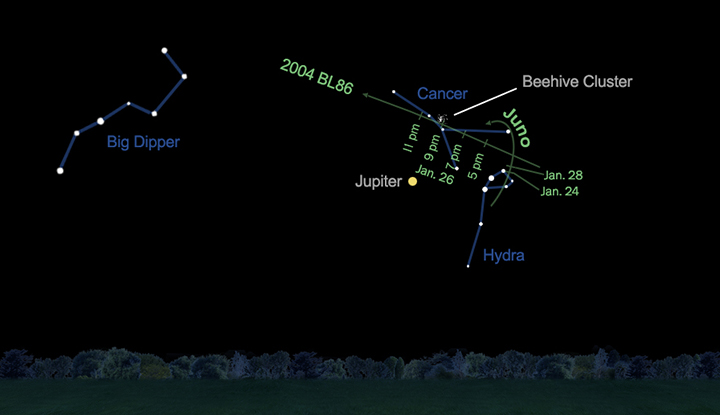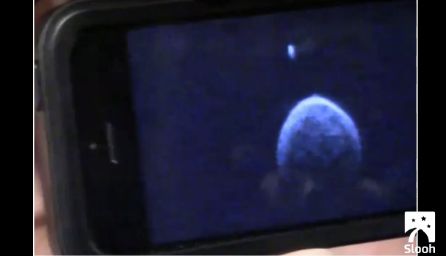Mountain-Size Asteroid Makes Close Flyby of Earth

A mountain-size asteroid buzzed Earth Monday morning (Jan. 26) in a close encounter that's already revealing new information about the space rock, including an improved measurement of its size and the confirmation of at least one moon.
Asteroid 2004 BL86 came within 745,000 miles (1.2 million kilometers) of Earth — or about three times the distance from our planet to the moon — Monday at approximately 11:20 a.m. EST (1620 GMT).
The space rock is now zooming off into the depths of space at 35,000 mph (56,300 km/h), researchers said. [Photos: Asteroids in Deep Space]
On Monday night, from 11 p.m. to 1 a.m. EST (0400 to 0600 GMT), scientists at NASA's Marshall Space Flight Center in Alabama will observe 2004 BL86 as it recedes from Earth. You can watch a webcast of the asteroid observations here on Space.com, or directly via Marshall's Ustream feed. The asteroid will reach a luminosity of magnitude 9 in the sky Monday, which is bright enough to be seen with binoculars or small telescopes.

At 11 a.m. EST (1600 GMT) on Monday, the Slooh Community Observatory aired a live webcast discussing new images of the asteroid and its trajectory.
During the webcast, NASA scientist Lance Benner showed photos of 2004 BL86 taken earlier in the day using a radar signal from the space agency's Deep Space Network facility in Goldstone, California. The new observations have a resolution of about 13 feet (4 meters) per pixel, and reveal that 2004 BL86 is roughly 1,000 feet (300 m) wide. This is significantly smaller than previous estimates, which put the asteroid's diameter at roughly 1,800 feet (550 m).
The new images also show a second object positioned close to 2004 BL86. Benner told Space.com that the second object is a moon, with a diameter between 164 and 328 feet (50 and 100 m). Previous studies of the light around 2004 BL86 had already identified a moon orbiting the asteroid, and the new images confirm that discovery, he added. About 17 percent of asteroids in 2004 BL86's size range have smaller objects trailing along with them.
Get the Space.com Newsletter
Breaking space news, the latest updates on rocket launches, skywatching events and more!
Boulders and other small-scale features on the surface of the asteroid are coming into focus in the new images, as is the overall shape of the asteroid, according to Benner. He compared the object to another asteroid that made a close flyby of Earth six years ago, called 2008 EV5. It appears that 2004 BL86, like 2008 EV5, has an equatorial ridge around its middle, which makes it look "kind of like a muffin, or perhaps a top," said Benner, who's based at NASA's Jet Propulsion Laboratory (JPL) in Pasadena, California.
While 2004 BL86 posed no threat to Earth on this pass, it is classified as a potentially hazardous asteroid, or PHA, which is an object that comes within about 5 million miles (8 million km) of Earth. NASA has identified about 1,500 PHAs in the solar system, according to Paul Chodas, manager of JPL's Near-Earth Object Program office, who also spoke on the webcast.
Chodas discussed why the flyby is exciting for scientists studying asteroids.
"This is like a space mission to an asteroid, only the asteroid is coming to us. So it's kind of a freebie," Chodas said. "We get to see it up close with large optical telescopes. We'll get an idea of its rotation rate, we'll get an idea of its composition […] by taking its spectrum. And with radar especially, we'll be able to get an idea of what this asteroid looks like, up close and personal."

The study of asteroids could answer fundamental questions about the formation of objects in our solar system, including planets, the scientists said. Some theories suggest asteroids are responsible for depositing most of the water on Earth. Scientists are also interested in the possibility of mining asteroids for useful materials such as platinum, palladium and water.
This will not be Earth's last encounter with 2004 BL86. Chodas said the asteroid will make another close approach to Earth in about 200 years, and will continue to make subsequent close flybys in the centuries to follow.
"Now that we have the radar data [of 2004 BL86] from both last night and tonight, we'll be able to predict this much further into the future," Chodas said. "And over the centuries, and as far as a millennia, this asteroid will be approaching slightly closer each time. So it's definitely one we'll want to keep our eye on."
Follow Calla Cofield @callacofield. Follow us @Spacedotcom, Facebook and Google+. Original article on Space.com.
Join our Space Forums to keep talking space on the latest missions, night sky and more! And if you have a news tip, correction or comment, let us know at: community@space.com.

Calla Cofield joined Space.com's crew in October 2014. She enjoys writing about black holes, exploding stars, ripples in space-time, science in comic books, and all the mysteries of the cosmos. Prior to joining Space.com Calla worked as a freelance writer, with her work appearing in APS News, Symmetry magazine, Scientific American, Nature News, Physics World, and others. From 2010 to 2014 she was a producer for The Physics Central Podcast. Previously, Calla worked at the American Museum of Natural History in New York City (hands down the best office building ever) and SLAC National Accelerator Laboratory in California. Calla studied physics at the University of Massachusetts, Amherst and is originally from Sandy, Utah. In 2018, Calla left Space.com to join NASA's Jet Propulsion Laboratory media team where she oversees astronomy, physics, exoplanets and the Cold Atom Lab mission. She has been underground at three of the largest particle accelerators in the world and would really like to know what the heck dark matter is. Contact Calla via: E-Mail – Twitter









